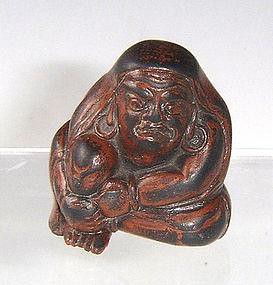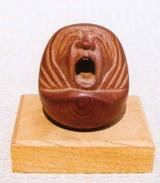. Paintings and prints of Daruma San .
:::::::::::::::::::::::::::::::::::::::::::::::::::::::::::::::::::::::::::::::::::::::::::::::::::::
Scrolls with Daruma 掛け軸 kakejiku
Many Daruma Scrolls introduced here are from extensive internet search of Ebay, Trocadero and other soucres.
http://www.trocadero.com/
Since they usually disappear soon from the web, I have prepared a safecopy in my photoalbum.
... gabigreve /album/
I wish to express my thanks to the many dealers who show their Daruma scrolls online. If this little collection would help to promote the sales, I will be happy ! And if you want to share them here directly too, please go ahead.

CLICK for more images.
:::::::::::::::::::::::::::::::::::::::::::::::::::::::::::::::::::::::::::::::::::::::::::::::::::::

source : arttattler.com
Suiô Genro (Japanese, 1716-1789)
遂翁元廬 (1717 - 1790) Suio Genro
:::::::::::::::::::::::::::::::::::::::::::::::::::::::::::::::::::::::::::::::::::::::::::::::::::::

from Tomioka collection 富岡重憲コレクション
- source : waseda.jp/aizu - Aizuyaichi museum -
:::::::::::::::::::::::::::::::::::::::::::::::::::::::::::::::::::::::::::::::::::::::::::::::::::::
Zen Art Gallery Shambhala

In Zen art, the master does not paint Daruma as an historical figure (or even a saint) but as a symbol of penetrating insight, self-reliance, ceaseless diligence, and the rejection of all externals. In order to bring the image of Daruma to life with brush and ink, the artist must become Daruma. Thus, a Daruma painting is a spiritual self-portrait, based on the individual experience of each Zen master.
Look at this great Gallery of Daruma Scrolls.
... www.shambhala.com/zenart/
........................................................................................................
Jcollector
Daruma Under Bo Tree, Taisho

Humorous painting on Japanese Zen scroll featuring Daruma sitting beneath a bo tree, Taisho Era, c. 1912-1926. Colorful depiction with ink and colors on silk. Daruma, also known as Boddhidharma, is the known as the first patriarch of Zen Buddhism and said to have founded Kung Fu in China. In this entertaining rendering, he is pictured meditating under the halo of a bo tree. This unusual combination of a serious pose taken aback by an amusingly rendered expression gives an eye-catching overall effect.
Dimensions: 79” high, 21.5” wide.
Nr. 58/59
See Photo Album
....................................................................................................

- - - - - More in the album
- source : Dariusz on facebook
....................................................................................................
Gaun (1633 - 1701) - Crimson Daruma
This is a 17th Century painting of the enigmatic Daruma. Depicted with his robe clutched tightly to himself and his face is set in deep concentration. He appears to be summoning his will to control the tumultuous thoughts within. The calligraphic inscriptions are signed Myoitsu, and the top seal below his signature also reads Myoitsu. The seal below this reads Gaun. Gaun (Arima Ryodai) was a practitioner of calligraphy and tea ceremony in Kyoto. He died in 1701 at the age of 69. The larger seal at the top left reads ‘Zenkoku …….Hakurankai’. This translates to ‘the all Japan exhibition of painted treasures’. The painting has just been cleaned and re-mounted – the previous brocade was worn beyond repair. The gold used for the calligraphy, and the deep, crimson red pigments of his robe have faded. It is now in fine condition, and completely stable. The scroll measures 77 by 20 inches.
Nr. 60/61
See Photo Album
.............................................................................................................
.. .. .. .. .. .. The Kura
Murasakino Kita-ku Kyoto
The Kura was established in 1994 in the ancient capitol and cultural heart of Japan, Kyoto. It has a lot of other Daruma items too.
http://www.the-kura.com/
WILD VINTAGE Japanese DARUMA SCROLL, GOZAN
An erratic mid 20th century Daruma painting signed Gozan in the original signed wooden box; the almost frenzied aspect of the brushwork balanced with the morose look on the legendary figures face. Of course, the Daruma is the founder of Zen Buddhism, and is attributed by the Chinese as the originator of Shao-Lin Kung-Fu. We have been unable to find any information on Gozan; however the name (five mountains) is certainly that of a priest (as originally in Japan the five main sects of Buddhism were represented by five mountain temples). The watercolor and ink on paper image, taken from an unusual angle and reminiscent of the works of the artist Tessai, is set in a very clean border of dark brown cloth, extended in beige. There is some age staining present on the image, but due to the peculiar style of the painting, actually blends in to the background. The scroll measures 19-1/4 by 62 inches (48 x 155 cm).
Nr. 21/22
See Photo Album
ZENGA DARUMA SCROLLS, KIUN

A lovely Sanpuku set of three bright early 20th century sumi-e scrolls, Ichi-gyo Calligraphy scrolls framing an image of the Daruma, legendary founder of Zen Buddhism. The signature is a bit difficult to read, but the stamps read Kiun (upper) and Hosen (lower). Typical of characters used for a priestfs name. Each ink work is framed in fresh green brocade featuring bone rollers and measures 7-1/4 by 77-1/2 inches (18.5 x 197 cm).
Six Tips to Protect Your Hanging Scrolls
:::::::::::::::::::::::::::::::::::::::::::::::::::::::::::::::::::::::::::::::::::::::::::::::::::::::::::::::::::::::::::
Six Tips to Protect Your Hanging Scrolls
When it comes to hanging scrolls, conservators believe that preventive care is the best medicine.
Tip #2 Handle scrolls in the traditional manner
- source : www.asianart.org
:::::::::::::::::::::::::::::::::::::::::::::::::::::::::::::::::::::::::::::::::::::::::::::::::::::::::::::::::::::::::::
Photo from my friend Ishino

Detail

:::::::::::::::::::::::::::::::::::::::::::::::::::::::::::::::::::::::::::::::::::::::::::::::::::::
"Daruma riding leaves to cross the seas to Japan"
attributed to Hokusai or Oi (葛飾 応為, c. 1800–c. 1866), his daughter.
:::::::::::::::::::::::::::::::::::::::::::::::::::::::::::::::::::::::::::::::::::::::::::::::::::::
My LINKs
Scroll in a Tokonoma, Japan
::::::::::::::::::::::::::::::::::::::::::
...................... Look at My Photo Album
:::::::::::::::::::::::::::::::::::::::::::::::::::::::::::::::::::::::::::::::::::::::::::::::::::::::::::::::::::::::::::
fuuchin, fūchin 風鎮 Fuchin, hanging-scroll weight

. . . CLICK here for Photos !
- reference -
:::::::::::::::::::::::::::::::::::::::::::::::::::::::::::::::::::::::::::::::::::::::::::::::::::::::::::::::::::::::::::

sumi-e 墨絵 painting with ink and brush
Ink and wash painting is an East Asian type of brush painting also known as ink wash painting. Only black ink — the same as used in East Asian calligraphy — is used, in various concentrations.
In Western art, works on paper in similar techniques are generally classified with drawings.
..... Ink wash painting developed in China during the Tang Dynasty (618-907).
© More in the WIKIPEDIA !
SUMI-E SOCIETY OF AMERICA
East Asian Brush Painting
source : www.sumiesociety.org
:::::::::::::::::::::::::::::::::::::::::::::::::::::::::::::::::::::::::::::::::::::::::::::::::::::

Sumitsubo Gassen
Kobaien Nara, Tsubai-Cho 7 - 古梅園 - 古墨 古梅園
奈良県奈良市椿井町7
source : 古梅園
:::::::::::::::::::::::::::::::::::::::::::::::::::::::::::::::::::::::::::::::::::::::::::::::::::::
. Paintings of Daruma
how to paint your own Daruma ! .
:::::::::::::::::::::::::::::::::::::::::::::::::::::::::::::::::::::::::::::::::::::::::::::::::::::
suibokuga 水墨画 ink paintings

When you draw the traditional images, such as geisya, samurai or Buddha, it is key point how to draw the neck line. I build up the neck line of this dharma image inspired by Sesshu and Hakuin.
Kazu Shimura
Look at a video of this painting in process:
source : sumi-e.jp/museum/bodydharma.htm
:::::::::::::::::::::::::::::::::::::::::::::::::::::::::::::::::::::::::::::::::::::::::::::::::::::::::::::::::::::::::::::::::::
二荒山墨絵ぼかしに霾れり
Futaara san sumie bokashi ni tsuchi fureri
an ink painting
of Futarasan in all gradations -
it is raining sand
Matsuzaki Tetsunosuke
. Yellow sand 黄砂 (こうさ) koosa .
:::::::::::::::::::::::::::::::::::::::::::::::::::::::::::::::::::::::::::::::::::::::::::::::::::::
墨絵にもほのかなる紅風光る
sumi-e ni mo honoka naru momiji kaze hikaru
even in this ink painting
a tint of red autumn leaves -
shining wind
Fukushima Kazu 福島加津
曙の墨絵の雲や糸ざくら
akebono no sumi-e no kumo ya itozakura
in morning dawn
the clouds like ink paintings -
hanging cherry blossoms
Izumi Kyooka 泉鏡花 Izumi Kyoka
(1873 - 1939)
簀戸ごしに浮世のさまの墨絵めく
sudo goshi ni ukiyo no sama na sumi-e meku
Oosaka Getsuooshi 逢坂月央子 Osaka Getsuoshi
かかりたる墨絵達磨の忌日かな
kakaritaru sumi-e Daruma no kinichi kana
Tokumoto Eisui 徳本映水
:::::::::::::::::::::::::::::::::::::::::::::::::::::::::::::::::::::::::::::::::::::::::::::::::::::
杉山の墨絵ぼかしに牡丹鍋
sugiyama no sumi-e bokashi ni botan nabe
the ink painting
of a cedar forest in all gradations -
wild boar stew
Kiuchi Shooshi 木内彰志 Kiuchi Shoshi
(1935 - 2006)

source : www.grace-tsumugi.com
A Sumi-e hanging scroll decorated with pine trees and clouds,
by Shibata Zeshin.
柴田是真 墨絵杉山
:::::::::::::::::::::::::::::::::::::::::::::::::::::::::::::::::::::::::::::::::::::::::::::::::::::

source : buddhanet.net/lineart...
:::::::::::::::::::::::::::::::::::::::::::::::::::::::::::::::::::::::::::::::::::::::::::::::::::::
. Paintings and prints of Daruma San .
[ . BACK to WORLDKIGO . TOP . ]
[ . BACK to DARUMA MUSEUM TOP . ]
:::::::::::::::::::::::::::::::::::::::::::::::::::::::::::::::::::::::::::::::::::::::::::::::::::::













































